Summary: This content discusses the attack activities of the threat actor MirrorFace, including their targets, tactics, techniques, and procedures (TTPs), and the vulnerabilities they exploit.
Threat Actor: MirrorFace | MirrorFace
Victim: Various organizations in Japan
Key Point :
- MirrorFace has been targeting media, political organizations, think tanks, universities, manufacturers, and research institutions.
- The threat actor initially used spear phishing emails to infiltrate networks but has now started leveraging vulnerabilities in external assets.
- JPCERT/CC published a security alert regarding the exploitation of vulnerabilities by MirrorFace, specifically targeting Array AG and FortiGate.
JPCERT/CC has been observing attack activities by MirrorFace LODEINFO and NOOPDOOR malware (since 2022). The actor’s targets were initially media, political organisations, think tanks and universities, but it has shifted to manufacturers and research institutions since 2023. As for the TTPs, they used to send spear phishing emails to infiltrate the target’s network, but now they also leverage vulnerabilities in external assets. Figure 1 shows the actor’s attack activity transition.
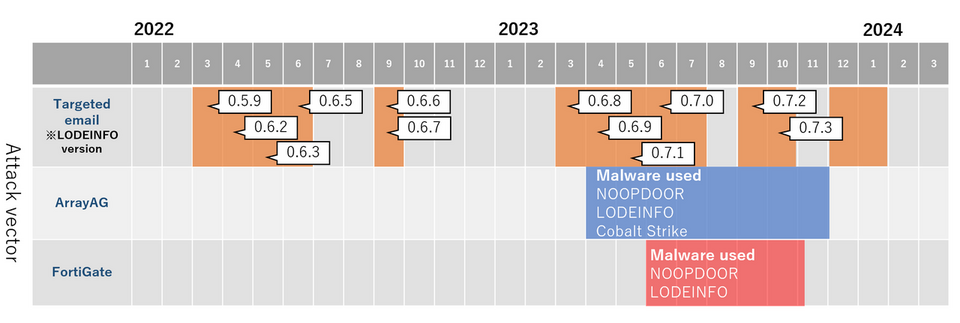
(Based on incident reports submitted to JPCERT/CC and publications by other vendors[1] [2])
JPCERT/CC published a security alert (Japanese) on attack activities exploiting vulnerabilities in November 2023. We have confirmed that this actor has leveraged the vulnerabilities in Array AG and FortiGate. Proself may also be exploited, but the cases mentioned in this blog post focus on those related to Array AG and Fortigate.
This blog describes the malware NOOPDOOR and details of the TTPs and tools the actor used in the victim network.
NOOPDOOR
NOOPDOOR execution flow
NOOPDOOR is a shellcode, and it injects itself into a legitimate application. It runs either by an XML file (Type1) or a DLL file (Type2). The execution flow of each type is illustrated in Figure 2 and 3.
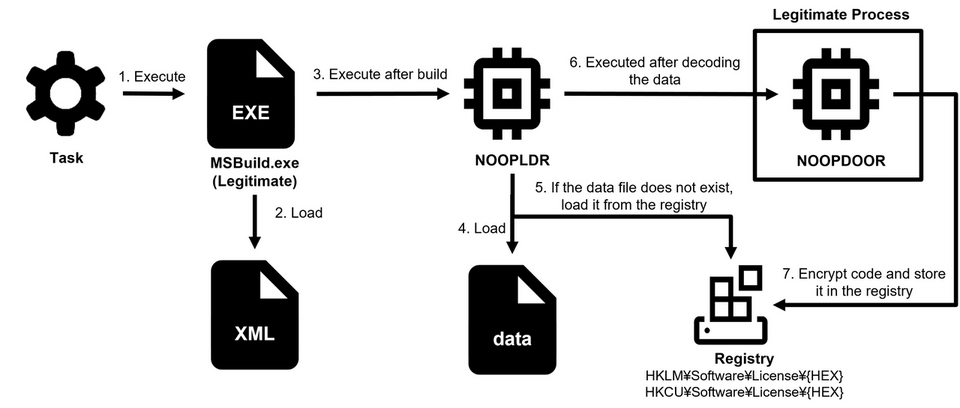
Type1 has its obfuscated C# code in an XML file. It builds the C# code with MSBuild and runs by NOOPDOOR’s loader (hereafter ‘NOOPLDR’). Once it runs, it reads specific data file or registry value, decrypts the data loaded in AES (CBC mode) based on the machine’s unique MachineId and ComputerName, and injects the code into a legitimate application.
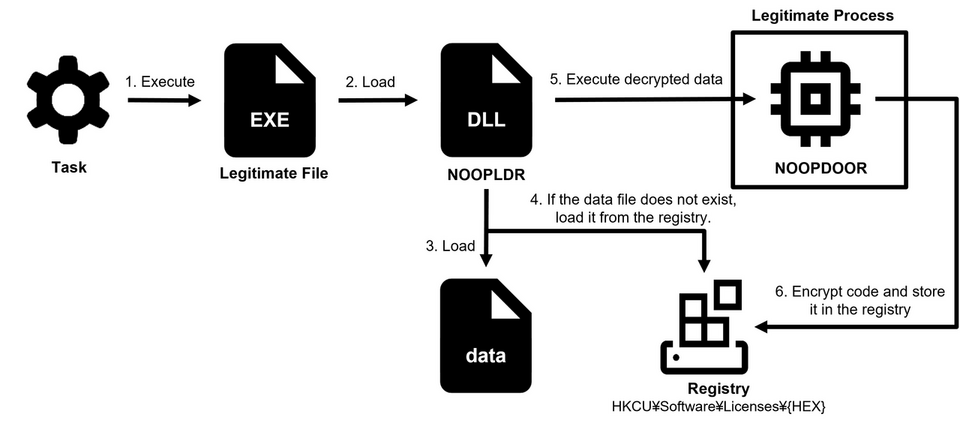
Type2 launches a legitimate application from Windows tasks, and NOOPLDR is loaded to a legitimate application by DLL side-loading. Similar to Type1, it loads the registry and injects decrypted code into a legitimate application. After NOOPDOOR is executed, both Type1 and Type2 encrypt the code, which is stored in a preset registry so that it is loaded when it runs again.
Types of NOOPLDR
There are several types of NOOPLDR samples with different injection process and functions as follows.
| How it runs | Injection process | Service | Storage registry |
| XML | lsass.exe | – | HKLMSoftwareLicense{HEX}, HKCUSoftwareLicense{HEX} |
| XML | tabcal.exe | – | HKLMSoftwareLicense{HEX}, HKCUSoftwareLicense{HEX} |
| XML | rdrleakdiag.exe | – | HKLMSoftwareLicense{HEX}, HKCUSoftwareLicense{HEX} |
| XML | svchost.exe | – | HKLMSoftwareLicense{HEX}, HKCUSoftwareLicense{HEX} |
| XML | wuauclt.exe | – | HKLMSoftwareLicense{HEX}, HKCUSoftwareLicense{HEX} |
| XML | vdsldr.exe | – | HKLMSoftwareLicense{HEX}, HKCUSoftwareLicense{HEX} |
| XML | prevhost.exe | – | HKLMSoftwareLicense{HEX}, HKCUSoftwareLicense{HEX} |
| DLL | wuauclt.exe | Yes | HKCUSoftwareMicrosoftCOM3{HEX} |
| DLL | None | – | HKCUSoftwareLicenses{HEX} |
| DLL | svchost.exe | – | HKCUSoftwareLicenses{HEX} |
Some Type2 samples with service registration capability has a function to hide the service by running the following command.
sc start [SERVICE_NAME] && sc sdset [SERVICE_NAME] D:(D;;DCLCWPDTSD;;;IU)(D;;DCLCWPDTSD;;;SU)(D;;DCLCWPDTSD;;;BA)(A;;CCLCSWLOCRRC;;;IU)(A;;CCLCSWLOCRRC;;;SU)(A;;CCLCSWRPWPDTLOCRRC;;;SY)(A;;CCDCLCSWRPWPDTLOCRSDRCWDWO;;;BA)S:(AU;FA;CCDCLCSWRPWPDTLOCRSDRCWDWO;;;WD)
NOOPLDR obfuscation
NOOPLDR (Type2) uses Control Flow Flattening (CFF) technique as in Figure 4 (left). The code can be partially analysed with D810[3] and other CFF deobfuscator tools, but it is not possible to fully deobfuscate the entire code as it also has many meaningless Windows API calls. To make this process easier, JPCERT/CC developed a tool to help this analysis. The code can be deobfuscated by applying this tool and then D810 and other deobfuscator tools as in Figure 4 (right).
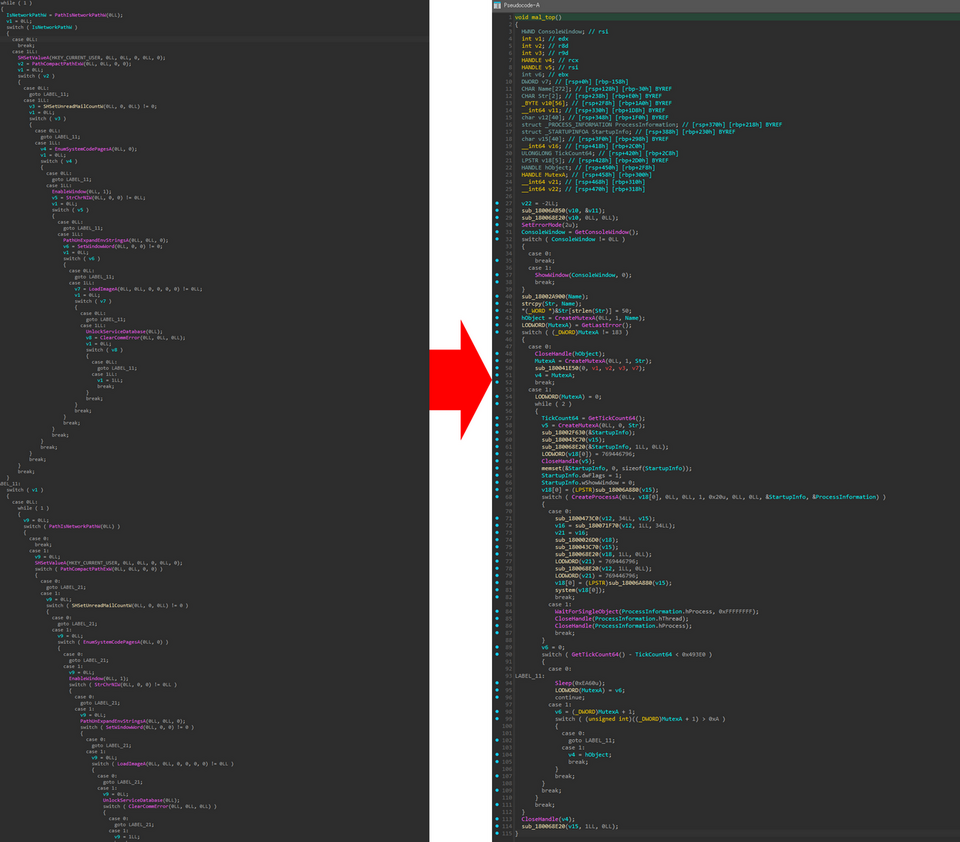
JPCERT/CC’s tool to support NOOPLDR deobfuscation is available on the below Github repository.
GitHub: JPCERTCC/aa-tools/Deob_NOOPLDR.py
https://github.com/JPCERTCC/aa-tools/blob/master/Deob_NOOPLDR.py
NOOPDOOR functions
NOOPDOOR has several functions such as communicating to Port 443 with the destination generated by the DGA based on the system time and receiving commands by TCP Port 47000. On top of the basic malware behaviour including uploading/downloading files and executing additional commands, it also has commands to alter file time stamps, which may confuse forensic analysis.
Please refer to the presentation material[4] by Dominik Breitenbacher at JSAC2024 for more details on the NOOPDOOR command structure and behaviour.
Threat actors activity on the network
The following sections explain the commands, tools and defense evasion techniques used by the attackers.
Access credentials
The attackers attempt accessing Windows network credentials by multiple methods.
(1) From Lsass memory dump
- They aim to extract credentials by accessing the memory dump of a currently running Lsass process by using a tool.
- Access to Lsass memory dump can be detected in an environment with Microsoft Defender. (Event log Windows Defender/Operational: Event ID 1011: Detection name Trojan:Win32/LsassDump)
(2) From NTDS.dit
- They aim to extract credentials by accessing the domain controller database file (NTDS.dit).
- They aim to access NTDS.dit by Vssadmin command etc.
- Access to NTDS.dit is recorded in the event logs. (Please refer to JPCERT/CC’s Tool Analysis Result Sheet[5] [6].)
(3) From registry hives
- They also aim to access SYSTEM, SAM, SECURITY registry hives to retrieve credentials from SAM database.
These activities can be detected depending on the EDR products.
Lateral Movement
The attackers attempt to access a wide range of clients and servers by leveraging Windows network admin privilege. It is especially recommended to carefully look at servers that are managed by privileged users such as file servers, AD, anti-virus software management servers. Attackers carry out lateral movement by copying the malware via SMB and registering it to the tasks (by schtasks command).
The series of activities can be recorded and monitored by Windows event logs. Creation of a new scheduled task is recorded with the Event ID 4698. Additionally, if “Audit Detailed File Share” is enabled, copying the malware via SMB is recorded in the Security event log with the Event ID 5145. (Please see Appendix D for setting details.) Below is sample event log recorded when a file is copied by an attacker (Event ID 5145).
A network share object was checked to see whether client can be granted desired access
Subject:
Security ID: [ID]
Account Name: [User name]
Account Domain: [Domain name]
Logon ID: [Logon ID]
Network Information:
Object Type: File
Source Address: [IP address]
Source Port: [Port]
Share Information:
Share Name: *C$
Share Path: ??C:
Relative Target Name: WINDOWSSYSTEM32UIANIMATION.XML
Access Request Information:
Access Mask: 0x120089
Accesses: READ_CONTROL
SYNCHRONIZE
ReadData (or ListDirectory)
ReadEA
ReadAttributes
Reconnaissance command
After the intrusion, the attackers were carrying out reconnaissance activities by using Windows commands as below. This includes commands that are not used by general users, which may be a clue to detect malicious activities.
at auditpol bitsadmin del dir dfsutil dsregcmd hostname ipconfig nbtstat net netstat ntfrsutl nslookup mountvol ping powercfg qprocess quser qwinsta reg sc setspn schtasks systeminfo tasklist vdsldr ver vssadmin wevtutil whoami wmic
Information exfiltration
Aside from NOOPDOOR, the attackers used the following tools to exfiltrate information.
- WinRAR
- SFTP
The attackers attempt to exfiltrate information after reviewing file contents. We have confirmed that they ran dir /s commands to see the list of files in the file server and stored the results in a RAR file. In addition, the attackers also used the following commands to see the list of files, including the folders in OneDrive, Teams, IIS, etc.
cmd.exe /c dir c: cmd.exe /c dir c:users cmd.exe /c dir c:usersDesktop cmd.exe /c dir c:usersDocuments cmd.exe /c dir "c:usersOneDrive" /s /a cmd.exe /c dir "c:usersOneDriveMicrosoft Teams" cmd.exe /c dir "c:usersOneDriveMicrosoft Teams チャット ファイル[redacted].docx" cmd.exe /c dir "c:Program Files" cmd.exe /c dir "c:Program Files (x86)" cmd.exe /c dir c:Intel cmd.exe /c dir c:inetpub cmd.exe /c dir c:inetpubwwwroot
Other tools
The attackers also use tools other than LODEINFO and NOOPDOOR. In some cases, we confirmed that GO Simple Tunnel (GOST), a HTTP/SOCKS5 proxy tool, was leveraged.
GitHub: ginuerzh/gost
https://github.com/ginuerzh/gost
We also saw cases where GOST was running on Linux servers. Also, Linux servers may also be infected with TinyShell-based malware.
Defense Evasion
The attackers used various techniques for defense evasion including the following. (Please see Appendix C for more details on TTPs.)
(1) Leverage MSBuild
- Execute a malicious XML file (NOOPLDR) by using a legitimate MSBuild
(2) Store malicious data in a registry
- Load encrypted malware file, store the data in the registry and delete the original file
(3) Alter time stamp
- Change the creation date of the malware and tools older than the actual attack date
(4) Add a rule to a firewall
- Add a new setting to allow communication to specific ports that NOOPDOOR uses
- Recorded in Event log Firewall With Advanced Security/Firewall with the Event ID 2004
(5) Hide registered services
- Set access control so that the registered services are not displayed
(6) Delete Windows Event logs
- Delete system logs
- Recorded with Event ID 1102
(7) Disable Windows Defender
- Recorded in Windows Defender/Operational with the Event ID 5001
(8) Delete files
- Delete the malware file
After completing the series of reconnaissance activities, the attackers deleted the malware and stopped its own processes. This is supposed to be conducted for a purpose of covering up the traces to allow long-term persistence.
cmd.exe /c del c:Windowssystem32UIAnimation.xml /f /q taskkill.exe
In closing
MirrorFace has been conducting attacks against Japanese organisations for a long period of time. Activities related to this actor is expected continue, and it is advised to continuously look out for information on this actor. Please refer to Appendix A for detailed IoC information.
In some cases, early detection based on IoCs may be difficult. In order to detect this kind of incidents with security products and services in an early stage, we believe it is crucial to maintain information sharing among security vendors about malware and TTPs for some extent. JPCERT/CC is committed to continue working with partner organisations and security vendors for timely information sharing about such attack activities.
Acknowledgement
JPCERT/CC would like to acknowledge the support by the organisations for this publication.
Security vendors who supported this publication
- ITOCHU Cyber & Intelligence Inc.
- Macnica, Inc.
- Secureworks, Inc.
We also referred to the report from the following companies:
- LAC Co., Ltd.
- Trend Micro Incorporated
Yuma Masubuchi, Kota Kino, Shusei Tomonaga
(Translated by Yukako Uchida)
Reference
[1] JSAC2024: Spot the Difference: An Analysis of the New LODEINFO Campaign by Earth Kasha
https://jsac.jpcert.or.jp/archive/2024/pdf/JSAC2024_2_7_hara_shoji_higashi_vickie-su_nick-dai_en.pdf
[2] ITOCHU Cyber & Intelligence Inc.: 分析官と攻撃者の解析回避を巡る終わりなき戦い: LODEINFO v0.6.6 – v0.7.3 の解析から (Japanese)
https://blog.itochuci.co.jp/entry/2024/01/24/134047
[3] GitHub: D-810
https://github.com/joydo/d810
[4] JSAC2024: Unmasking HiddenFace: MirrorFace’s most complex backdoor yet
https://jsac.jpcert.or.jp/archive/2024/pdf/JSAC2024_2_8_Breitenbacher_en.pdf
[5] JPCERT/CC: Tool Analysis Result Sheet ntdsutil
https://jpcertcc.github.io/ToolAnalysisResultSheet/details/ntdsutil.htm
[6] JPCERT/CC: Tool Analysis Result Sheet vssadmin
https://jpcertcc.github.io/ToolAnalysisResultSheet/details/vssadmin.htm
Appendix A: IoC
- 45.66.217.106
- 89.233.109.69
- 45.77.12.212
- 108.160.130.45
- 207.148.97.235
- 95.85.91.15
- 64.176.214.51
- 168.100.8.103
- 45.76.222.130
- 45.77.183.161
- 207.148.90.45
- 207.148.103.42
- 2a12:a300:3600::31b5:2e02
- 2001:19f0:7001:2ae2:5400:4ff:fe0a:5566
- 2400:8902::f03c:93ff:fe8a:5327
- 2a12:a300:3700::5d9f:b451
Appendix B: Malware hash values
NOOPLDR Type1
- 93af6afb47f4c42bc0da3eedc6ecb9054134f4a47ef0add0d285404984011072
- bcd34d436cbac235b56ee5b7273baed62bf385ee13721c7fdcfc00af9ed63997
- 43349c97b59d8ba8e1147f911797220b1b7b87609fe4aaa7f1dbacc2c27b361d
- 4f932d6e21fdd0072aba61203c7319693e490adbd9e93a49b0fe870d4d0aed71
- 0d59734bdb0e6f4fe6a44312a2d55145e98b00f75a148394b2e4b86436c32f4c
- 9590646b32fec3aafd6c648f69ca9857fb4be2adfabf3bcaf321c8cd25ba7b83
- 572f6b98cc133b2d0c8a4fd8ff9d14ae36cdaa119086a5d56079354e49d2a7ce
NOOPLDR Type2
- 7a7e7e0d817042e54129697947dfb423b607692f4457163b5c62ffea69a8108d
- 5e7cd0461817b390cf05a7c874e017e9f44eef41e053da99b479a4dfa3a04512
- b07c7dfb3617cd40edc1ab309a68489a3aa4aa1e8fd486d047c155c952dc509e
Appendix C: MITRE ATT&CK
| Techniques | ID | Name | Description |
| Initial Access | T1133 | External Remote Services | Exploit VPN product vulnerability and access network |
| Execution | T1053.005 | Scheduled Task/Job: Scheduled Task | Execute NOOPLDR by a scheduled task |
| Persistence | T1053.005 | Scheduled Task/Job: Scheduled Task | Set a scheduled task to execute malware automatically |
| T1543.003 | Create or Modify System Process: Windows Service | Register a service and execute malware automatically | |
| Privilege Escalation | T1134.002 | Access Token Manipulation: Create Process with Token | Manipulate access tokens to create a process |
| Defense Evasion | T1055 | Process Injection | Use a legitimate EXE file under C:windowssystem32, perform NOOPDOOR process injection and execute |
| T1070.001 | Clear Windows Event Logs | Delete system logs | |
| T1070.004 | File Deletion | Delete malware and tools | |
| T1070.006 | Timestomp | Change the file creation date | |
| T1112 | Modify Registry | Store NOOPDOOR in a registry | |
| T1127.001 | Trusted Developer Utilities Proxy Execution: MSBuild | Use a legitimate MSBuild.exe to run a malicious XML file | |
| T1140 | Deobfuscate/Decode Files or Information | Decrypt NOOPDOOR and execute in the injected process | |
| T1562.001 | Disable or Modify Tools | Disable Windows Defender | |
| T1562.004 | Disable or Modify System Firewall | Add a rule to allow communication to the ports that NOOPDOOR uses | |
| T1564 | Hide Artifacts | Set access restriction so that the services related to autorun NOOPDOOR are not visible | |
| Credential Access | T1003 | OS Credential Dumping | Dump credentials from lsass and ntds.dit |
| Discovery | T1087 | Account Discovery | Collect account information |
| T1083 | File and Directory Discovery | Collect file information | |
| Lateral Movement | T1021.002 | SMB/Windows Admin Shares | Spread malware to other systems via SMB |
| Collection | T1560.001 | Archive Collected Data: Archive via Utility | Compress data witih WinRAR |
| T1039 | Data from Network Shared Drive | Collect data stored in Network Shared Drive | |
| Command and Control | T1568.002 | Dynamic Resolution: Domain Generation Algorithms | Change destination based on DGA |
Appendix D: Enable “Audit Detailed File Share”
The audit policy on Windows OS can be configured in Group Policy Editor (gpedit.msc). Please enable it from Computer Configuration >> Windows Settings >> Security Settings >> Advanced Audit Policy Configuration >> System Audit Policies >> Object Access >> “Audit Detailed File Share”.
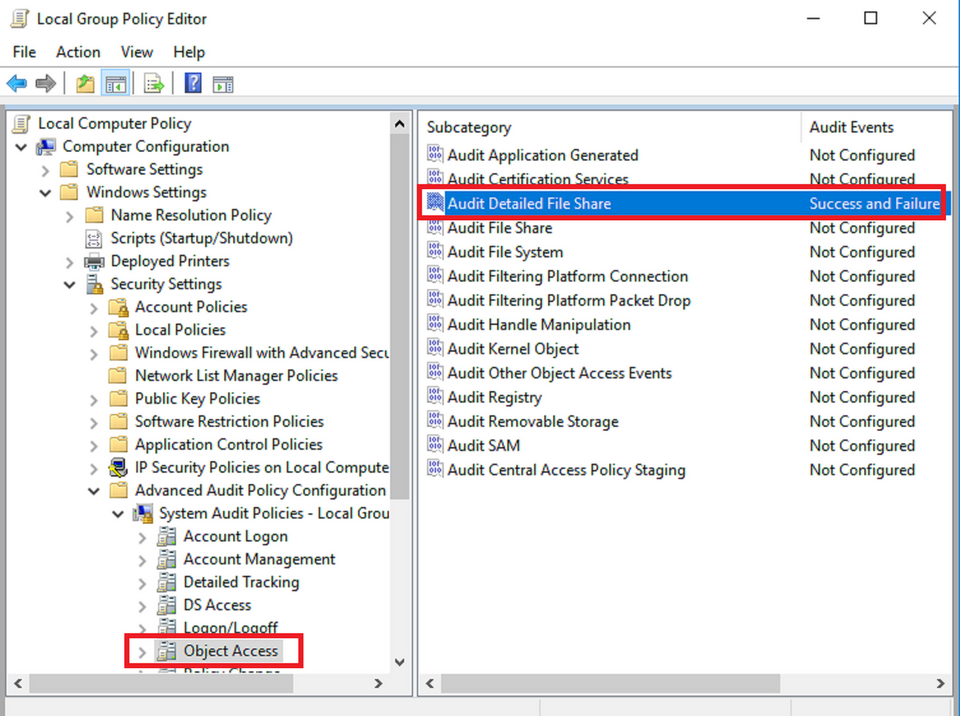
Source: https://blogs.jpcert.or.jp/en/2024/07/mirrorface-attack-against-japanese-organisations.html
“An interesting youtube video that may be related to the article above”